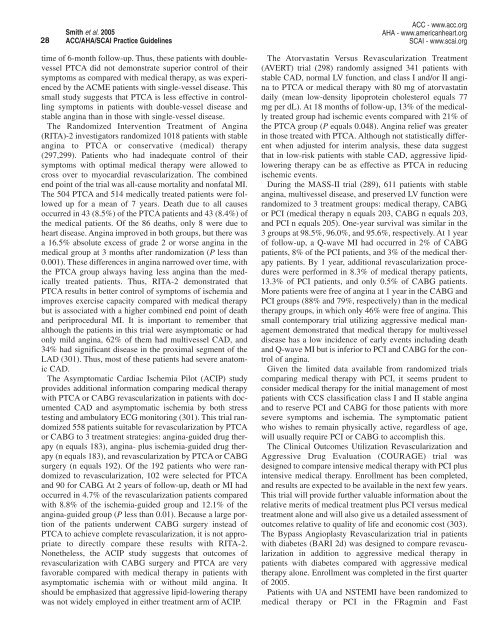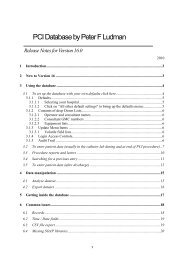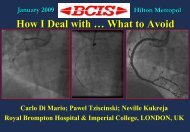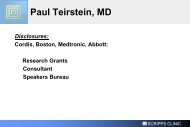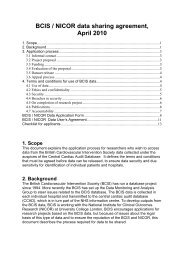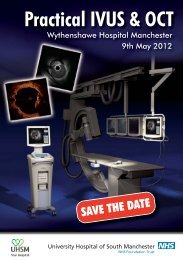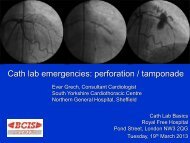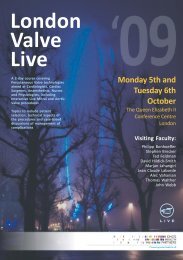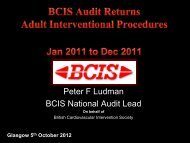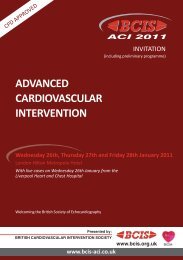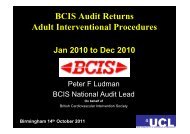Recommendations
ACC/AHA/SCAI PCI Guidelines - British Cardiovascular Intervention ...
ACC/AHA/SCAI PCI Guidelines - British Cardiovascular Intervention ...
- No tags were found...
Create successful ePaper yourself
Turn your PDF publications into a flip-book with our unique Google optimized e-Paper software.
28<br />
Smith et al. 2005<br />
ACC/AHA/SCAI Practice Guidelines<br />
ACC - www.acc.org<br />
AHA - www.americanheart.org<br />
SCAI - www.scai.org<br />
time of 6-month follow-up. Thus, these patients with doublevessel<br />
PTCA did not demonstrate superior control of their<br />
symptoms as compared with medical therapy, as was experienced<br />
by the ACME patients with single-vessel disease. This<br />
small study suggests that PTCA is less effective in controlling<br />
symptoms in patients with double-vessel disease and<br />
stable angina than in those with single-vessel disease.<br />
The Randomized Intervention Treatment of Angina<br />
(RITA)-2 investigators randomized 1018 patients with stable<br />
angina to PTCA or conservative (medical) therapy<br />
(297,299). Patients who had inadequate control of their<br />
symptoms with optimal medical therapy were allowed to<br />
cross over to myocardial revascularization. The combined<br />
end point of the trial was all-cause mortality and nonfatal MI.<br />
The 504 PTCA and 514 medically treated patients were followed<br />
up for a mean of 7 years. Death due to all causes<br />
occurred in 43 (8.5%) of the PTCA patients and 43 (8.4%) of<br />
the medical patients. Of the 86 deaths, only 8 were due to<br />
heart disease. Angina improved in both groups, but there was<br />
a 16.5% absolute excess of grade 2 or worse angina in the<br />
medical group at 3 months after randomization (P less than<br />
0.001). These differences in angina narrowed over time, with<br />
the PTCA group always having less angina than the medically<br />
treated patients. Thus, RITA-2 demonstrated that<br />
PTCA results in better control of symptoms of ischemia and<br />
improves exercise capacity compared with medical therapy<br />
but is associated with a higher combined end point of death<br />
and periprocedural MI. It is important to remember that<br />
although the patients in this trial were asymptomatic or had<br />
only mild angina, 62% of them had multivessel CAD, and<br />
34% had significant disease in the proximal segment of the<br />
LAD (301). Thus, most of these patients had severe anatomic<br />
CAD.<br />
The Asymptomatic Cardiac Ischemia Pilot (ACIP) study<br />
provides additional information comparing medical therapy<br />
with PTCA or CABG revascularization in patients with documented<br />
CAD and asymptomatic ischemia by both stress<br />
testing and ambulatory ECG monitoring (301). This trial randomized<br />
558 patients suitable for revascularization by PTCA<br />
or CABG to 3 treatment strategies: angina-guided drug therapy<br />
(n equals 183), angina- plus ischemia-guided drug therapy<br />
(n equals 183), and revascularization by PTCA or CABG<br />
surgery (n equals 192). Of the 192 patients who were randomized<br />
to revascularization, 102 were selected for PTCA<br />
and 90 for CABG. At 2 years of follow-up, death or MI had<br />
occurred in 4.7% of the revascularization patients compared<br />
with 8.8% of the ischemia-guided group and 12.1% of the<br />
angina-guided group (P less than 0.01). Because a large portion<br />
of the patients underwent CABG surgery instead of<br />
PTCA to achieve complete revascularization, it is not appropriate<br />
to directly compare these results with RITA-2.<br />
Nonetheless, the ACIP study suggests that outcomes of<br />
revascularization with CABG surgery and PTCA are very<br />
favorable compared with medical therapy in patients with<br />
asymptomatic ischemia with or without mild angina. It<br />
should be emphasized that aggressive lipid-lowering therapy<br />
was not widely employed in either treatment arm of ACIP.<br />
The Atorvastatin Versus Revascularization Treatment<br />
(AVERT) trial (298) randomly assigned 341 patients with<br />
stable CAD, normal LV function, and class I and/or II angina<br />
to PTCA or medical therapy with 80 mg of atorvastatin<br />
daily (mean low-density lipoprotein cholesterol equals 77<br />
mg per dL). At 18 months of follow-up, 13% of the medically<br />
treated group had ischemic events compared with 21% of<br />
the PTCA group (P equals 0.048). Angina relief was greater<br />
in those treated with PTCA. Although not statistically different<br />
when adjusted for interim analysis, these data suggest<br />
that in low-risk patients with stable CAD, aggressive lipidlowering<br />
therapy can be as effective as PTCA in reducing<br />
ischemic events.<br />
During the MASS-II trial (289), 611 patients with stable<br />
angina, multivessel disease, and preserved LV function were<br />
randomized to 3 treatment groups: medical therapy, CABG,<br />
or PCI (medical therapy n equals 203, CABG n equals 203,<br />
and PCI n equals 205). One-year survival was similar in the<br />
3 groups at 98.5%, 96.0%, and 95.6%, respectively. At 1 year<br />
of follow-up, a Q-wave MI had occurred in 2% of CABG<br />
patients, 8% of the PCI patients, and 3% of the medical therapy<br />
patients. By 1 year, additional revascularization procedures<br />
were performed in 8.3% of medical therapy patients,<br />
13.3% of PCI patients, and only 0.5% of CABG patients.<br />
More patients were free of angina at 1 year in the CABG and<br />
PCI groups (88% and 79%, respectively) than in the medical<br />
therapy groups, in which only 46% were free of angina. This<br />
small contemporary trial utilizing aggressive medical management<br />
demonstrated that medical therapy for multivessel<br />
disease has a low incidence of early events including death<br />
and Q-wave MI but is inferior to PCI and CABG for the control<br />
of angina.<br />
Given the limited data available from randomized trials<br />
comparing medical therapy with PCI, it seems prudent to<br />
consider medical therapy for the initial management of most<br />
patients with CCS classification class I and II stable angina<br />
and to reserve PCI and CABG for those patients with more<br />
severe symptoms and ischemia. The symptomatic patient<br />
who wishes to remain physically active, regardless of age,<br />
will usually require PCI or CABG to accomplish this.<br />
The Clinical Outcomes Utilization Revascularization and<br />
Aggressive Drug Evaluation (COURAGE) trial was<br />
designed to compare intensive medical therapy with PCI plus<br />
intensive medical therapy. Enrollment has been completed,<br />
and results are expected to be available in the next few years.<br />
This trial will provide further valuable information about the<br />
relative merits of medical treatment plus PCI versus medical<br />
treatment alone and will also give us a detailed assessment of<br />
outcomes relative to quality of life and economic cost (303).<br />
The Bypass Angioplasty Revascularization trial in patients<br />
with diabetes (BARI 2d) was designed to compare revascularization<br />
in addition to aggressive medical therapy in<br />
patients with diabetes compared with aggressive medical<br />
therapy alone. Enrollment was completed in the first quarter<br />
of 2005.<br />
Patients with UA and NSTEMI have been randomized to<br />
medical therapy or PCI in the FRagmin and Fast


